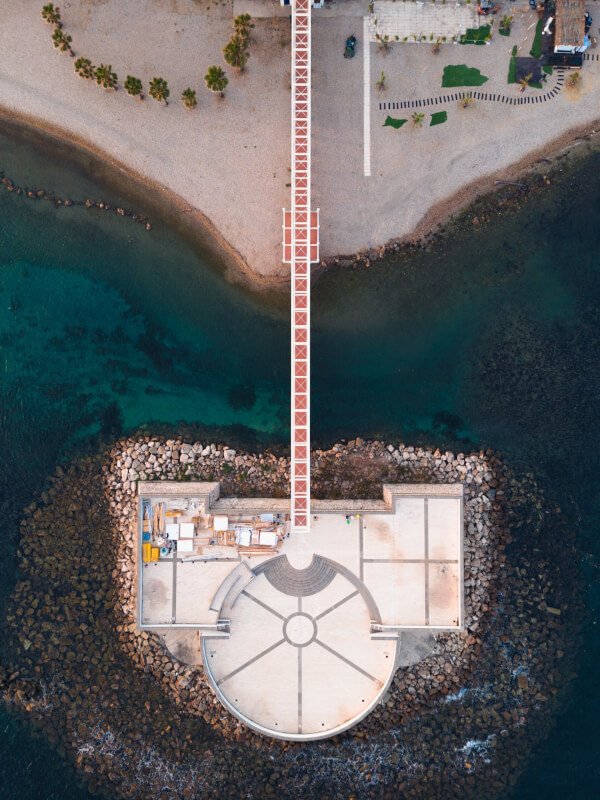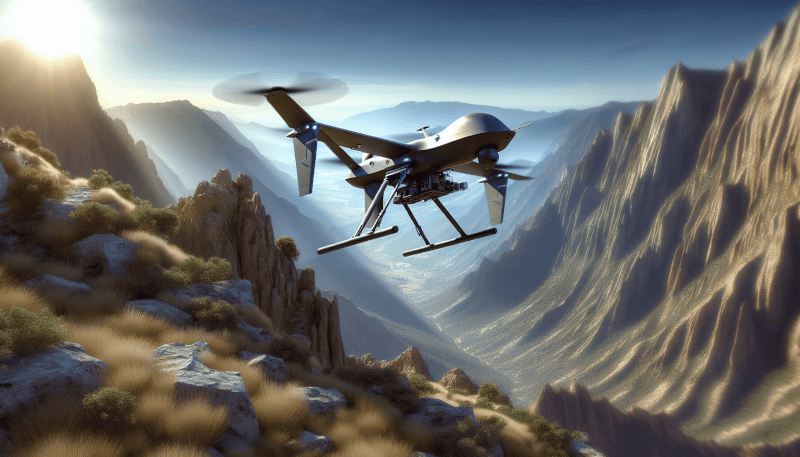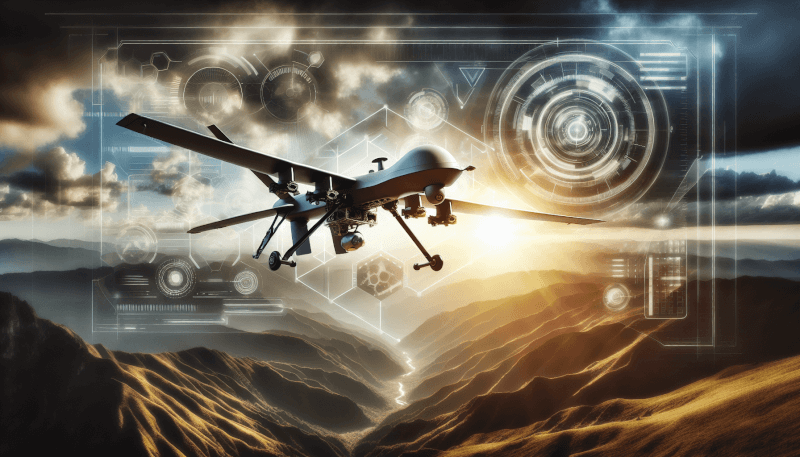Imagine a world where unmanned drones play a crucial role in military operations and defense strategies, providing a higher level of efficiency, accuracy, and safety. This captivating article explores the exciting future of drone technology in the military and defense sectors. From autonomous surveillance to delivering supplies in remote areas, these unmanned wonders are revolutionizing how we approach security and combat. Get ready to be spellbound as we unravel the endless possibilities and potential they hold for the future.

Overview of Drone Technology
Drones, also known as unmanned aerial vehicles (UAVs), are remotely operated or autonomously guided flying machines. These aircraft have gained significant attention and usage in recent years due to their versatility and practical applications. Drone technology has seen remarkable advancements, allowing drones to perform a wide range of functions, from surveillance and reconnaissance to delivery of supplies. Understanding the history and current use of drones, as well as their potential benefits and limitations, is crucial in exploring their role in the military and defense sectors.
Definition of drones
Drones are aerial vehicles that do not require a human pilot onboard. They can be operated remotely or fly autonomously using pre-programmed flight paths or artificial intelligence algorithms. Drones come in various shapes and sizes, from small quadcopters to large fixed-wing aircraft. Equipped with cameras, sensors, and other payload systems, drones are capable of performing a wide range of tasks, making them indispensable in various industries, including the military and defense sectors.
Brief history of drone technology
The roots of drone technology can be traced back to the early 20th century. In 1918, the U.S. Army developed the first unmanned aerial torpedo, which was essentially a radio-controlled flying bomb. Throughout the following decades, advancements in technology led to the development of remotely operated aerial vehicles. During World War II, the German army used the V-1 “buzz bomb,” an early form of a cruise missile that could fly autonomously to its target. The Cold War era witnessed further progress in drone technology, with the United States and other nations using drones for reconnaissance missions.
It wasn’t until the 1990s that drones began to gain widespread attention and usage. Technological advancements, such as the miniaturization of components and improvements in communication systems, made drones more accessible and affordable. Military organizations around the world recognized the potential of drones for strategic and tactical purposes.
Current Use of Drones in Military and Defense
Surveillance and Reconnaissance
One of the primary uses of drones in the military and defense sectors is surveillance and reconnaissance. Drones equipped with high-resolution cameras, infrared sensors, and other imaging technologies can gather real-time intelligence and provide critical situational awareness to military personnel. By flying over hostile or inaccessible areas, drones can gather valuable information without putting human lives at risk. They can assess enemy positions, monitor troop movements, and identify potential threats.
Target Acquisition
Drones play a crucial role in target acquisition, helping military forces identify and track enemy assets. By using advanced sensors and target recognition algorithms, drones can detect and locate enemy vehicles, weapon installations, and personnel. This information is critical for planning and executing military operations effectively. Drones can provide real-time updates on enemy movements, allowing commanders to make informed decisions based on accurate and timely intelligence.
Mine Detection and Disposal
Another important application of drones in the military is mine detection and disposal. Traditional mine-clearing operations are dangerous and time-consuming, putting soldiers’ lives at risk. Drones equipped with specialized sensors can scan areas suspected of containing mines, identifying potential threats while keeping personnel safe. Once mines are detected, drones can be used to safely dispose of them, minimizing the risk of casualties and expediting the process.
Delivery of Supplies
Drones have the potential to revolutionize logistics and supply chain management in the military. In remote or inaccessible locations, delivering supplies to troops can be challenging and costly. Drones can overcome these challenges by transporting essential items, such as food, medical supplies, and ammunition, quickly and efficiently. This reduces the need for traditional transport methods, minimizes the risk to human life, and improves the overall efficiency of military operations.
Potential Benefits of Drone Technology in Military and Defense
Enhanced Situational Awareness
The use of drones in military operations significantly enhances situational awareness. By providing real-time aerial surveillance and intelligence, drones enable commanders to have a comprehensive understanding of the battlefield. This information is crucial for making strategic decisions, effectively deploying resources, and ensuring the safety of military personnel. With drones, military forces can gain a tactical edge by having an elevated perspective and a bird’s-eye view of the battlefield.
Reduced Risk to Human Life
One of the most significant benefits of using drones in the military and defense sectors is the reduced risk to human life. By deploying drones for reconnaissance, surveillance, and target acquisition missions, military personnel can stay out of harm’s way. Drones can be sent into hostile or dangerous environments without risking the lives of soldiers. This not only protects military personnel but also allows for more agile and effective operations.
Improved Efficiency
The use of drones in military operations improves efficiency across various aspects of warfare. Drones can cover large areas quickly and provide real-time information, enabling faster and more accurate decision-making. They can perform repetitive tasks tirelessly and consistently, reducing the fatigue and cognitive strain that humans may experience. The efficiency gained through drone technology allows military forces to allocate their resources effectively, optimize mission planning, and achieve operational objectives more efficiently.
Cost Savings
Drone technology also brings significant cost savings to the military and defense sectors. Compared to traditional aircraft or manned missions, operating drones is generally more cost-effective. Drones have lower fuel and maintenance costs, require fewer personnel to operate, and can be utilized for extended durations. Additionally, drones offer the advantage of being reusable, reducing the need for constant replacement or repair. These cost savings can be redirected towards other areas of military investment, such as training, research, and development of advanced technologies.
Challenges and Limitations of Drone Technology
Integration into Existing Military Systems
Integrating drones into existing military systems can pose challenges, particularly due to the complexity of the technology and the need for interoperability. Drones need to be seamlessly integrated into command, control, communication, computer, intelligence, surveillance, and reconnaissance (C4ISR) networks. This ensures effective coordination and communication between drones, manned aircraft, and ground forces. Achieving this integration requires significant investment in infrastructure and systems that can facilitate the seamless exchange of information.
Airspace Regulations and Safety Concerns
The proliferation of drone technology has given rise to concerns related to airspace regulations and safety. Unregulated or careless use of drones can pose risks to civilian aircraft, infrastructure, and human life. To mitigate these concerns, governments and regulatory bodies worldwide have implemented airspace regulations and safety measures specific to drones. These regulations aim to ensure safe and responsible drone operations, requiring operators to comply with altitude limits, obtain necessary licenses and permits, and follow designated flight paths. However, enforcing and monitoring these regulations can be challenging, particularly as drone technology continues to advance rapidly.
Cybersecurity and Vulnerabilities
As with any advanced technology, drones are susceptible to cybersecurity threats and vulnerabilities. Hackers could potentially hijack drones, manipulate flight paths, or disrupt communication between the drone and its operator. The consequences of such attacks could range from compromising sensitive military data to potentially using drones as weapons against friendly forces. Protecting drones and their associated systems from cyber threats requires robust encryption, authentication protocols, and ongoing cybersecurity measures. Continuous research and development are essential to stay ahead of evolving cyber threats and protect military assets effectively.
Ethical and Legal Issues
The use of drones in military operations raises significant ethical and legal concerns. Autonomous drones, for example, raise questions about the role of human decision-making in warfare and the potential for unintended consequences. Additionally, concerns about privacy arise as drones equipped with cameras can capture images and video footage without consent. Striking the balance between the military benefits of drones and ethical considerations requires careful policy development, adherence to international humanitarian law, and transparent decision-making processes. Regulations and guidelines must be in place to ensure the responsible and ethical use of drone technology in military and defense operations.

Advancements in Drone Technology
Autonomous Systems and Artificial Intelligence
Advancements in drone technology have led to the development of autonomous systems powered by artificial intelligence (AI). These drones can perform complex tasks independently, using machine learning algorithms to evaluate and respond to changing environments. Autonomous drones have the potential to revolutionize military operations by enhancing decision-making capabilities, optimizing mission execution, and adapting to dynamic situations in real-time.
Swarming and Cooperative Behavior
The concept of drone swarms involves multiple drones operating cooperatively and synchronously to achieve a common goal. Swarming drones can work together to cover larger areas, overwhelm enemy defenses, and perform complex tasks that would be challenging for a single drone. Through communication and collaboration, swarming drones can exhibit collective intelligence, making them highly effective in military operations. Swarming capabilities have the potential to enhance surveillance, reconnaissance, and even combat capabilities.
Improved Payload Capacity and Flight Endurance
Advancements in drone technology have enabled significant improvements in payload capacity and flight endurance. This means drones can carry larger and more varied payloads, such as advanced sensors, high-resolution cameras, and even weapons. Increased flight endurance allows drones to remain airborne for extended periods, providing persistent intelligence and surveillance support to military forces. These advancements expand the range of tasks that drones can perform and enhance their effectiveness in military operations.
Stealth and Countermeasure Technologies
Modern drone technology includes stealth features that enable them to operate covertly and minimize their visibility to enemy defenses. Stealth capabilities, such as reduced radar cross-section, acoustic signatures, and thermal profile, enhance the survivability and effectiveness of drones in hostile environments. Furthermore, countermeasure technologies, including electronic warfare systems and anti-aircraft defenses, are being developed to detect and neutralize enemy drones. These advancements in stealth and countermeasure technologies provide military forces with increased flexibility and protect against emerging drone threats.
Future Applications of Drone Technology in the Military
Combat Operations
The future of drone technology in military operations includes the use of drones in combat. The ability to carry and deploy weapons, coupled with advancements in AI, autonomy, and swarming capabilities, will allow drones to actively engage in combat scenarios. This includes the use of drones in airstrikes, engaging enemy forces, and supporting ground troops. Combat-focused drones have the potential to change the dynamics of warfare, providing increased precision, agility, and coordination.
Logistics and Supply Chain Management
Drones will continue to play a significant role in improving logistics and supply chain management in the military. Rapid advancements in delivery drone technology will enable efficient transportation of supplies, equipment, and humanitarian aid to remote or inaccessible areas. Automated logistics systems, combined with drones, will enhance the speed and accuracy of supply chain operations, reducing costs and improving the overall efficiency of military logistics.
Mapping and Surveying
Drones equipped with advanced imaging systems will continue to be valuable tools for mapping and surveying purposes. High-resolution cameras, LiDAR scanners, and other sensors can generate detailed 3D maps, topographical data, and terrain analysis. These mapping capabilities are crucial for mission planning, route selection, and identifying potential threats in unknown or hazardous areas. Drones will play a vital role in providing accurate and up-to-date geospatial intelligence to support military operations.
Search and Rescue Operations
Drones have already proven their worth in search and rescue operations, and their role will continue to expand in the future. Equipped with thermal imaging cameras, drones can locate and track missing persons in challenging environments, such as dense forests or disaster-stricken areas. Drones can swiftly deploy life-saving equipment, communicate with stranded individuals, and assist in coordinating rescue efforts. The use of drones in search and rescue operations provides a cost-effective and efficient solution for saving lives in critical situations.

Developments in Drone Defense and Countermeasures
Anti-Drone Systems
As drones become more prevalent, the need for effective anti-drone systems has grown. These systems aim to detect, track, and neutralize hostile drones that pose a threat to military installations or personnel. Anti-drone systems employ technologies such as radar, radio frequency (RF) sensors, and electro-optical/infrared (EO/IR) sensors to detect and track drones. Once detected, countermeasures such as electronic jamming, netting systems, or kinetic solutions can be deployed to neutralize the threat.
Drone Detection and Identification
Drone detection and identification technologies are crucial for maintaining situational awareness and distinguishing between friendly and hostile drones. These systems use a combination of radar, acoustics, RF, and optical sensors to detect and classify drones in real-time. By providing accurate and timely information about the presence of drones, military forces can respond swiftly and effectively to potential threats.
Jamming and Disruption Technologies
Jamming and disruption technologies play a vital role in countering hostile drones. These technologies can disrupt the communication signals between a drone and its operator, rendering them ineffective or forcing them to return to their initial launch location. By jamming GPS, radio, or wireless frequencies, military forces can hinder enemy drone operations and prevent unauthorized access to sensitive areas. Jamming and disruption technologies will continue to evolve alongside advancements in drone capabilities.
Directed Energy Weapons
Directed energy weapons, such as lasers and microwaves, offer a promising solution for neutralizing hostile drones. These weapons employ high-energy beams to disable or destroy drones, delivering a precise and fast response. Directed energy weapons can quickly disable multiple drones without the need for ammunition resupply, making them an efficient and cost-effective solution for drone defense. As the technology matures, directed energy weapons will provide the military with a scalable and adaptable anti-drone capability.
Collaboration and Integration with Other Technologies
Integration with Artificial Intelligence
The integration of drones with artificial intelligence (AI) systems offers immense potential for military applications. AI can enhance the autonomy and decision-making capabilities of drones, enabling them to adapt to changing conditions and respond to dynamic environments. By leveraging AI algorithms, drones can analyze vast amounts of real-time data and make informed decisions independently. The integration of AI and drones opens up opportunities for more efficient and effective military operations.
Augmented Reality and Virtual Reality
The use of augmented reality (AR) and virtual reality (VR) technologies can enhance the training and simulation capabilities of drone operators and military personnel. AR and VR can provide immersive training environments that replicate real-world scenarios, allowing operators to practice mission planning, flight control, and tactical decision-making. These technologies will play a crucial role in improving the proficiency and preparedness of drone operators, resulting in safer and more efficient operational outcomes.
Communication and Network Systems
Effective communication and network systems are essential for enhancing the capabilities of drones and their integration into military operations. Reliable communication networks enable seamless coordination between drones, ground forces, and command centers. Secure, low-latency data transfer ensures real-time situational awareness and information sharing. High-bandwidth communication links are crucial for transmitting high-resolution imagery, video feeds, and telemetry data. The development of resilient and robust communication and network systems will support the seamless integration of drones into military operations.
Internet of Things
The Internet of Things (IoT) holds immense potential for enhancing the capabilities of military drones. By connecting drones to IoT-enabled devices and systems, military forces can leverage real-time data from a vast array of sensors and platforms. IoT-based systems can provide drone operators with comprehensive environmental data, mission-specific information, and real-time intelligence. This integration enables enhanced decision-making capabilities, mission optimization, and effective utilization of resources.

Emerging Trends and Future Possibilities
Miniaturization and Micro-drones
Advancements in miniaturization technologies will lead to the development of smaller and more agile drones. Miniature drones, sometimes referred to as micro-drones, offer unique advantages such as enhanced maneuverability, stealth capabilities, and increased payload capacity relative to their size. These drones can be deployed in confined spaces, navigate complex environments, and perform specialized tasks such as surveillance within dense urban areas.
Biologically Inspired Drone Design
Inspired by nature, biologically inspired drone design seeks to mimic the capabilities of living organisms. Biomimetic drones can replicate features such as bird-like flight, insect-like agility, and fish-like underwater capabilities. These drones are designed to operate in specific environments and perform specialized tasks. Biologically inspired drone design offers the potential for more efficient flight performance, increased endurance, and improved adaptability to challenging environments.
Quantum Computing and Encryption
Quantum computing and encryption technologies have the potential to revolutionize the security and resilience of drone communications and systems. Quantum computing can enhance encryption algorithms, making it nearly impossible for malicious actors to intercept and decrypt sensitive information. Secure quantum communication networks will provide a level of protection beyond current encryption methods, ensuring the integrity of drone data and preventing unauthorized access.
Drone Swarms for Urban Operations
Drone swarms hold immense potential for urban military operations, where the ability to quickly and effectively gather intelligence is crucial. Swarming drones can navigate complex urban environments, gather real-time data, and provide critical situational awareness to military forces. These drones can detect enemy movements, locate individuals, and assess the overall state of an urban environment. The deployment of drone swarms can significantly enhance the military’s ability to navigate and respond to urban warfare scenarios.
Conclusion
The future of drone technology in the military and defense sectors is filled with exciting possibilities. Drones have already proven their immense value in surveillance, reconnaissance, and logistics operations. However, their use in combat, search and rescue, and countermeasures against hostile drones is only beginning to be realized. With advancements in autonomy, artificial intelligence, and miniaturization, drones are poised to become even more efficient and effective tools for military forces worldwide.
The impact of drone technology on military operations cannot be overlooked. Drones provide enhanced situational awareness, reduce the risk to human life, improve efficiency, and offer significant cost savings. However, challenges such as integration into existing systems, airspace regulations, cybersecurity, and ethical dilemmas need to be addressed.
Continued advancements in drone technology, along with the development of defense and countermeasure systems, collaboration with other technologies, and emerging trends such as miniaturization and biologically inspired design, will shape the future of military and defense sectors. As drone technology evolves, defense strategy and policy must adapt to these advancements and address the potential risks that accompany them.
The future of drone technology in the military and defense sectors holds immense promise. However, careful consideration and responsible management are essential to maximize the benefits of this technology while mitigating its risks. Through continued advancements, collaboration, and strategic planning, drones will continue to revolutionize military operations and shape the future of defense.



